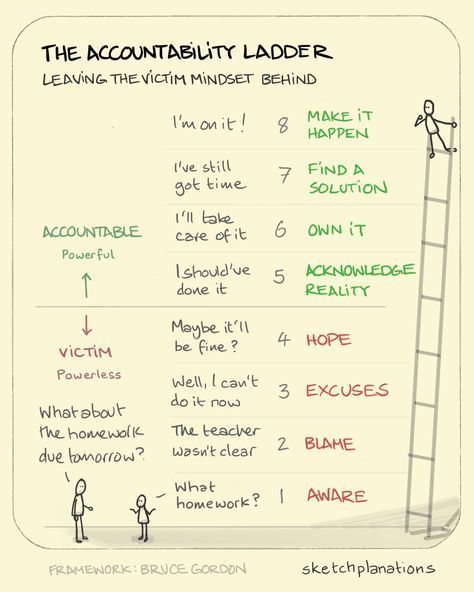I talk about accountability a lot, and enjoyed this image I saw on LinkedIn recently with a homework example applied against the ‘accountability ladder’. Being accountable is one of the most important qualities of leadership, and also of just being a good human being.

People with an Accountable mindset take responsibility for their actions, unlike people with a Victim mindset, who blame others for their failures or mistakes.
Here are the stages of the accountability ladder (as taken from Forbes):
At the lowest rung on the ladder, people are simply “Unaware” or “Unconscious.” They don’t even know there’s a situation that needs attention.
The next rung on the ladder is the “Blame Others” level. Here’s where we see a lot of finger pointing. When something goes wrong, or fails to go right, people at this level are quick to censure their colleagues. This is the behavior we frequently saw on “The Apprentice” when rather than fixing problems, most contestants invested their energy in fixing blame.
Just above the “Blame Others” rung on the Ladder of Accountability are the “Personal Excuses” and “I Can’t” levels. The behaviour we see here is sort of an adult version of “the dog ate my homework” syndrome. People talk themselves into believing, for a wide range of imaginative reasons, that they are simply unable to accomplish the task at hand. It’s never their fault, of course, because (they genuinely believe) they are controlled by circumstances.
Next we have the “Wait and Hope” level. Although waiting and hoping are better than blaming and making excuses, this is still a mindset that places the obligation for results on someone else. In fact, all the behaviours on these lower rungs on the Ladder of Accountability are victim behaviors. People who languish at these levels of performance (or non-performance) seem to believe that things happen to them.
At the “Acknowledge Reality” level, people at least have their heads out of the sand. They see the situation for what it is, sort the facts from the fiction, and accept the certainty that something needs to be changed.
An even higher rung on the ladder is the “Embrace It!” level. People operating at this level admit their own role in the problem, then accept ownership of the situation. People who psychologically “own” a problem are much more likely to solve it than people who merely acknowledge that a problem exists. The symptoms of psychological ownership are intense interest, passion, determination, and the persistent investment of energy. Psychological ownership reminds us of the old joke about ham and eggs. The chicken is merely involved, the pig is truly committed.
Just above the “Embrace It!” level is the “Find a Solution!” rung on the Ladder of Accountability. Solutions are spawned by commitment to results.
And the highest rung on the Ladder of Accountability is the “Make It Happen!” level. People who operate at this level don’t just talk about results, they get results. Their commitment is relentless (I didn’t say ruthless, I said relentless.)
These “Make It Happen!” people sometimes make the hand-wringers uncomfortable. They not only tend to think outside the box, they often refuse to accept the notion that “the box” even exists. They don’t take no for an answer. They gain special satisfaction in solving problems that others regard as impossible or just too difficult. They’re worth their weight in gold because they know that things happen because of them,not to them.
This is not to suggest that “Make It Happen!” people are renegades or organisational vigilantes. They not only feel accountable for results, they feel accountability to their colleagues. Good “Make It Happen!” people are very big on mutual respect and mutual purpose.
Of course with mutual respect and mutual purpose comes a willingness to account for one’s own performance. This includes accepting responsibility for personal performance shortfalls as well as accepting credit for personal performance triumphs.
—
How much accountability do you have? How much is there in your organisation? What could you do to increase it?
(Framework: Bruce Gordon. Sketchnote: Sketchplanations)